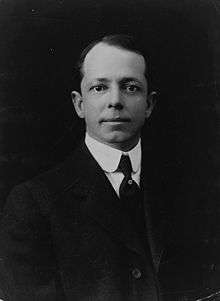Henry S. Graves
Henry ("Harry") Solon Graves (May 3, 1871 – March 7, 1951)[1] was a forest administrator in the United States. He co-founded the Yale Forest School (now the Yale School of Forestry and Environmental Studies) in 1900, the oldest continuous forestry school in the United States. He was appointed Chief of the United States Forest Service in 1910 and served in this position until 1920.

Biography
Graves was born in Marietta, Ohio. He attended Phillips Academy, Andover, graduating in 1888, and Yale University, graduating in 1892. He received a Master's degree from Yale in 1900. At Yale Graves was a member of the secret society Skull and Bones.[2]:160[3]
Graves, Walter Toumey and Gifford Pinchot established the Yale Forest School in 1900, the first graduate school dedicated to forestry in the United States. He served as its first Director [1900-1910] and returned as Dean of the forestry school [1923-1939]. Henry was the Provost of Yale University from 1923-1927.[4] In 1900, he and Pinchot were also two of the seven founding members of the Society of American Foresters.[5]

Graves was Chief of the United States Forest Service, from 1910 until 1920. Pinchot had served as the first Chief from the foundation of the Forest Service in 1905, but he was fired by President Howard Taft in 1910 for speaking out against Taft's environmental policies. As the leader of the Forest Service, Graves was considered very strict. During his ten-year term, Graves was faced with a lot of work. He had to try to restore the power that the Forest Service had before Pinchot was fired, and he also had to prove that his agency was the most qualified and best suited to control and manage the national forests, because many states wanted to manage their own forests.
Graves was commissioned as a major in the United States Army Corps of Engineers in 1917, during the First World War, and sent to France to prepare for the arrival of the 10th Engineers (Forestry) (later the 20th Engineers). He was promoted to lieutenant colonel and returned to the U.S. in 1918 and to the Forest Service. Later that year, he started a movement to help develop a National forest policy for the United States of America. Due to symptoms of "Meniere's Symbole",[6] Graves resigned from his position as Chief Forester, completing his duties in 1920.
Following his retirement in 1939, Graves was able to dedicate more time in assisting his good friend, George Dudley Seymour with managing the Hale Homestead ('The Birthplace' of Nathan Hale) in Coventry, Connecticut. Both Henry Graves and George Cromie [Yale Forest School, 1911 and 1st Superintendent of Trees, City of New Haven, CT] provided technical forestry management assistance to George Dudley Seymour for the woodlands surrounding the Hale Homestead, which would become the Nathan Hale State Forest in 1946.
In 1933, Connecticut State Forester, Austin Foster Hawes named a Civilian Conservation Corps (CCC) camp located in the Nipmuck State Forest in Union, "Camp Graves" in honor of Henry.
For his many years of dedication to the conservation and management of forests, Henry was the third person to receive the Schlich Memorial Award in 1944.
Honorary Degrees: Harvard University (M.A., 1911), Syracuse University (Law, 1924), Yale University (Doctor of Law, 1940). He was a member of the Connecticut Academy of Arts and Sciences.
The Henry Solon Graves Grove is located within Del Norte Coast Redwoods State Park. A stone marker in the grove, dedicated in 1926 reads: "The Grove of ancient Trees named in honor of Henry Solon Graves Forester, Educator and Administrator. A Leader of unusual ability in the profession of forestry in which he has rendered distinguished service to his country".
Henry married Ella Marian Welch (Vassar, A.B., 1895) on December 19, 1903.
See also
Notes
- http://mssa.library.yale.edu/obituary_record/1925_1952/1950-51.pdf
- The twelfth general catalogue of the Psi Upsilon Fraternity. 1917. Retrieved March 24, 2011.
- Yale University Manuscript and Archives Digital Images Database. 1892. Members of Skull and Bones Photographic Print
- "Archived copy". Archived from the original on 2012-11-30. Retrieved 2012-11-10.CS1 maint: archived copy as title (link)
- "About SAF: Who We Are". Society of American Foresters. Archived from the original on 2007-04-27. Retrieved 2007-05-06.
- Letter to George Dudley Seymour from Henry Graves, January 1919. Yale Manuscripts and Archives: George Dudley Seymour Papers MS 442
References
| Wikimedia Commons has media related to Henry S. Graves. |
- Henry S. Graves Profile (Forest History Society website)
- History of Yale School of Forestry and Environmental Studies
- The first American forestry award, Harold K. Steen, Forest History Today, Spring 2000, p. 42-43. (PDF)
External links
- Works by or about Henry S. Graves at Internet Archive
- Henry Solon Graves papers (MS 249). Manuscripts and Archives, Yale University Library.